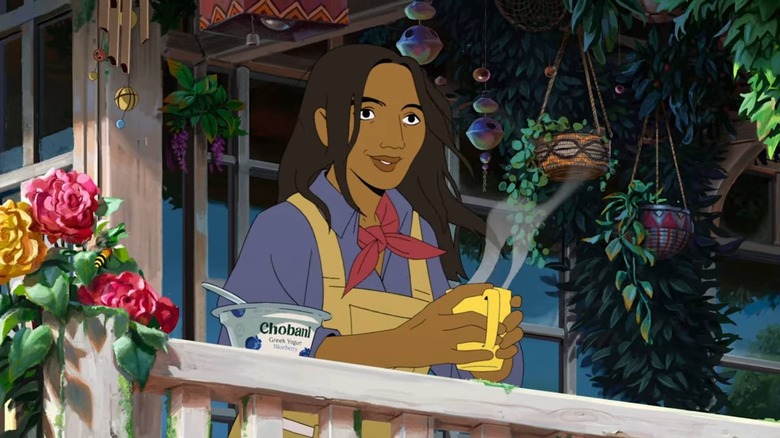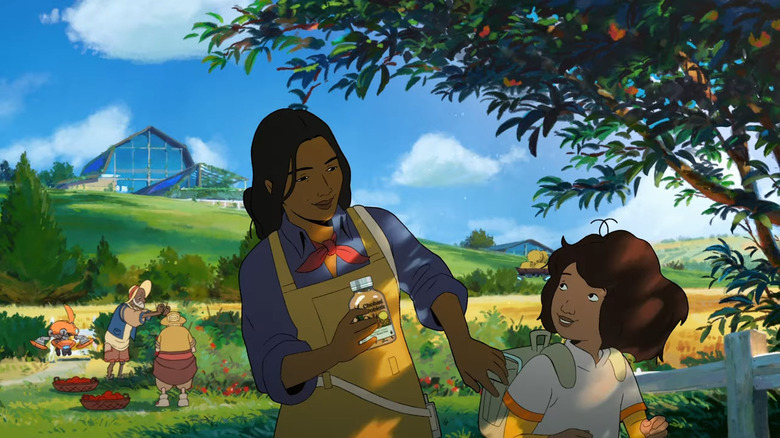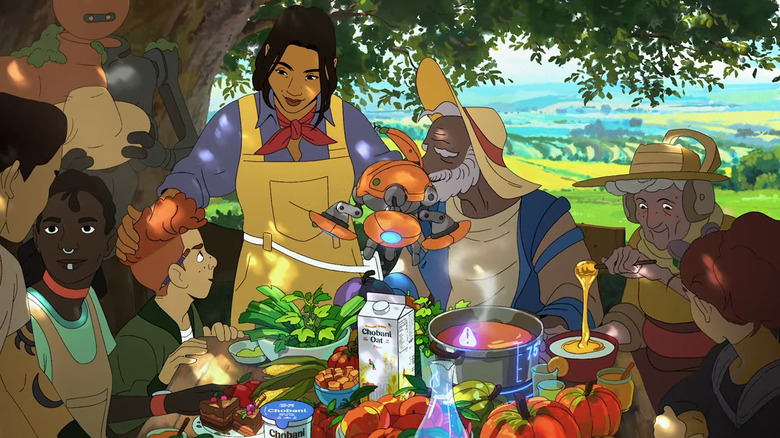What Is SolarPunk: How An Animated Ad Helped Define A Genre Aesthetic
When looking at commercials, one usually doesn't think about what literary or cinematic genre they fit into other than "Has a gecko mascot" or "Doesn't have a gecko mascot." That's what makes the "Dear Alice" ad from Chobani so intriguing and worthy of further discussion. Chobani is a food company perhaps best known for its Greek yogurt. But unlike many corporations, Chobani puts out an image of being more forward-thinking, such as offering various plant-based products. That's where the "Dear Alice" commercial comes into play.
While Chobani products can be found in the ad, the central focus is on a woman narrating a letter written by a grandmother to her granddaughter about how she wants to leave behind a more sustainable future for her. This is accompanied by numerous images of using land wisely for agriculture, where technology and nature can co-exist side by side. It's downright beautiful and perfectly encapsulates an artistic genre known as solarpunk.
You may have seen the solarpunk style before, even if you weren't fully aware of it. Let's break down why the "Dear Alice" commercial and solarpunk go hand-in-hand.
What is solarpunk?
You've likely heard of cyberpunk and steampunk before, which envision realities where societies more largely incorporate elements of cyber and steam technology, respectively. Solarpunk is cut from the same cloth, only it emphasizes a civilization centered on solar and other renewable technologies. The "punk" portion of the word refers to an act of rebellion and how achieving such a world is only attainable through collective rebellious actions against current capitalistic systems. Whereas cyberpunk is most often used in relation to dystopias, solarpunk envisions utopias where humanity works in harmony with nature.
Solarpunk exists as an artistic, literary, and cinematic subgenre that focuses on natural, aesthetic beauty, ecological sustainability, and decentralization. First and foremost, human beings must be at the center of a solarpunk design because ecological harmony means nothing if humans are extinct. This is why green technology and walkable cities are so often featured.
While solarpunk is a relatively new idea, many artworks have utilized aesthetics from the subgenre, even before it became an accepted idea. For example, Ursula K. LeGuin's "Always Coming Home" from 1985 could be considered an early solarpunk work, as it features a peaceful, egalitarian society that's moved beyond the need for a government.
There aren't a ton of solarpunk movies. However, the works of Studio Ghibli, including "Princess Mononoke" and "Nausicaä of the Valley of the Wind" could be seen as having a solarpunk aesthetic. Additionally, the 2022 Disney animated film, "Strange World," features characters using technology in a more sustainable manner. Solarpunk is steadily growing in mainstream acceptance, and oddly enough, the Chobani ad distills the genre into one minute.
Chobani's Dear Alice Commercial Explained
When watching the "Dear Alice" Chobani commercial, the first few images sum up solarpunk quite well. There are images of sustainable agricultural techniques, combined with more modern technology, such as a cow grazing while solar panels are overhead. Technology is used to enhance tried-and-true farming practices rather than to replace them with something that degrades nature.
From there, the ad pulls out, and viewers can see a large city in the distance. Solarpunk doesn't mean everyone has to live on a farm. Civilizations can still exist, and if one looks closely, the buildings in the city incorporate greenery to bring nature to brick-and-mortar. Solarpunk doesn't mean society has to regress to more egalitarian ways. It simply offers an alternative to destroying the environment for corporate gain while giving more power to the workers.
Most significantly, the "Dear Alice" ad captures the essence of solarpunk through the letter being read to the granddaughter. She repeatedly references how she wants to leave behind a better future for a new generation, and that's ultimately the goal of solarpunk. Cyberpunk often envisions a future no one wants to be born into. Solarpunk does the opposite; it shows a beautiful world anyone would be lucky to be born into.
Why the Dear Alice Ad's Decommodification Defines SolarPunk
Lastly, the decommodification of the "Dear Alice" commercial from Chobani drives everything else home. The solarpunk messaging would've been lost if it was a straightforward ad to sell yogurt. However, the commercialization aspect doesn't really factor here. Chobani products are featured throughout the ad, but attention isn't directed toward them. They're an afterthought, with more focus going on the gorgeous aesthetics and messaging of a sustainable future. Even the score, which hails from Studio Ghibli composer Joe Hisaishi, is stripped away of typical commercial jingles for something more soothing.
Decommodification even plays a role in the story of the ad itself. Food is integral to life, but under modern capitalist systems, it's viewed as a product rather than a fundamental right. There are no major corporations depicted in the harvesting of food, just people growing and sharing the literal fruits of their labor. Toward the end of the ad, people gather at a table to partake in a feast. Food is viewed as something to be shared, rather than to be hoarded or thrown away because there's no profit to be made.
Chobani clearly wants to center itself as a progressive company. At the end of the day, it is still a commercial to get people to buy a product, so consumers can adopt a progressive mindfulness for themselves. However, compared to most other commercials, there's a certain value in studying the art form on display here. Hopefully, it serves as a beacon of what's to come in terms of solarpunk aesthetics becoming more widespread in society, both in art and the machinations of capitalism itself.


